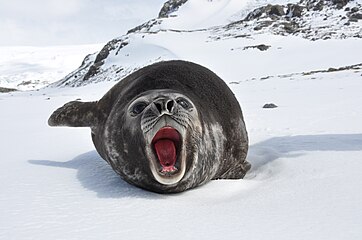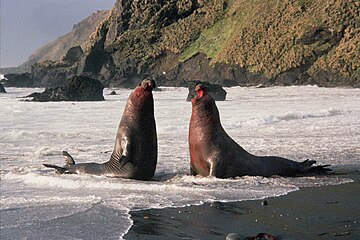Elephant seal
| Elephant seals | |
|---|---|
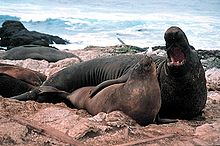
| |
| Male and female northern elephant seals | |
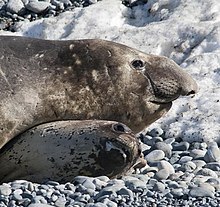
| |
| Male and female southern elephant seals | |
| Scientific classification | |
| Domain: | Eukaryota |
| Kingdom: | Animalia |
| Phylum: | Chordata |
| Class: | Mammalia |
| Order: | Carnivora |
| Clade: | Pinnipedia |
| Family: | Phocidae |
| Tribe: | Miroungini Muizon, 1981 |
| Genus: | Mirounga Gray, 1827 |
| Type species | |
Phoca leonina | |
| Species | |
Elephant seals or sea elephants are very large, oceangoing
The northern elephant seal, somewhat smaller than its southern relative, ranges over the
The oldest known unambiguous elephant seal fossils are fragmentary fossils of a member of the tribe Miroungini described from the late Pliocene Petane Formation of New Zealand.[2] Teeth originally identified as representing an unnamed species of Mirounga have been found in South Africa, and dated to the Miocene epoch;[3][4] however, Boessenecker and Churchill (2016) considered these teeth almost certainly to be misidentified toothed whale (odontocete) teeth.[2] The elephant seals evolved in the Pacific Ocean during the Pliocene period.[2][5][6]
Elephant seals breed annually and are seemingly habitual to colonies that have established breeding areas.[7]
Taxonomy
John Edward Gray established the genus Mirounga in 1827.[8] The generic name Mirounga is a Latinization of miouroung, which is said to have been a term for the seal in an Australian Aboriginal language. However, it is not known which language this represents.[9]
Description
Elephant seals are marine mammals classified under the order Pinnipedia, which, in Latin, means feather- or fin-footed.[10] Elephant seals are considered true seals, and fall under the family Phocidae.[11] Phocids (true seals) are characterized by having no external ear and reduced limbs.[11] The reduction of their limbs helps them be more streamlined and move easily in the water.[10] However, it makes navigating on land more difficult because they cannot turn their hind flippers forward to walk like the otariids.[10] In addition, the hind flippers of elephant seals have a lot of surface area, which helps propel them in the water.[10] Elephant seals spend the majority of their life (90%) underwater in search of food, and can cover 100 kilometres (60 miles) a day when they head out to sea.[11] When elephant seals are born, they can weigh up to 36 kilograms (79 pounds) and reach lengths up to 122 cm (4 ft 0 in).[11] Sexual dimorphism is extreme, with male elephant seals weighing up to 10 times more than females,[12] and having a prominent proboscis.[11]
Elephant seals take their name from the large proboscis of the adult male (bull), reminiscent of an elephant's trunk, and considered a secondary sexual characteristic.[13] The bull's proboscis is used in producing extraordinarily loud roaring noises, especially during the mating season. More importantly, however, the nose acts as a sort of rebreather, filled with cavities that reabsorb moisture from their exhalations.[14] This is important during the mating season when the seals do not leave the beach to feed, and must conserve body moisture as there is no incoming source of water. They are very much larger than other pinnipeds, with southern elephant seal bulls typically reaching a length of 5 m (16 ft) and a weight of 3,000 kg (7,000 lb), and are much larger than the adult females (cows), with some exceptionally large males reaching up to 6 m (20 ft) in length and weighing 4,000 kg (9,000 lb); cows typically measure about 3 m (10 ft) and 900 kg (2,000 lb). Northern elephant seal bulls reach a length of 4.3 to 4.8 m (14 to 16 ft) and the heaviest weigh about 2,500 kg (5,500 lb).[15][16]
The northern and southern elephant seal can be distinguished by various external features. On average, the southern elephant seal tends to be larger than the northern species.[12] Adult male elephant seals belonging to the northern species tend to have a larger proboscis, and thick chest area with a red coloration compared to the southern species.[12] Females do not have the large proboscis and can be distinguished between species by looking at their nose characteristics.[12] Southern females tend to have a smaller, blunt nose compared to northern females.[12]
Extant species distributions
| Common name | Scientific name and subspecies | Range | Size and ecology | IUCN status and estimated population |
|---|---|---|---|---|
| Northern elephant seal | Mirounga angustirostris (Gill, 1866) |
Eastern Pacific Ocean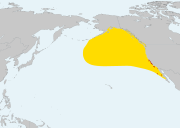
|
Size: Habitat: Diet: |
LC
|
| Southern elephant seal | Mirounga leonina (Linnaeus, 1758) |
South Atlantic
|
Size: Habitat: Diet: |
LC
|
Physiology

Elephant seals spend up to 80% of their lives in the ocean. They can hold their breath for more than 100 minutes
Elephant seals are shielded from extreme cold more by their
Elephant seals have a very large volume of blood, allowing them to hold a large amount of oxygen for use when diving. They have large sinuses in their
Elephant seals are able to slow down their heartbeat (bradycardia) and divert blood flow from the external areas of the body to important core organs.[11] They can also slow down their metabolism while performing deep dives.[11]
Elephant seals have a helpful feature in their bodies known as the countercurrent heat exchanger to help conserve energy and prevent heat loss.[11] In this system, arteries and veins are organized in a way to maintain a constant body temperature by having the cool blood flowing to the heart warmed by blood going to external areas of the animal.[11]
Milk produced by elephant seals is remarkably high in
Adaptations
Elephant seals have large circular eyes that have more
Their body is covered in blubber, which helps them keep warm and reduce drag while they are swimming.[11] The shape of their body also helps them maneuver well in the water, but limits their movement on land.[11] Also, elephant seals have the ability to fast for long periods of time while breeding or molting.[11] The turbinate process, another unique adaptation, is very beneficial when these seals are fasting, breeding, molting, or hauling out.[11][further explanation needed] This unique nasal structure recycles moisture when they breathe and helps prevent water loss.[11]
Elephant seals have external whiskers called vibrissae to help them locate prey and navigate their environment.[11] The vibrissae are connected to blood vessels, nerves, and muscles making them an important sensing tool.[10]
Due to evolutionary changes, their ear has been modified to work extremely well underwater.[10] The structure of the inner ear helps amplify incoming sounds, and allows these seals to have good directional hearing due to the isolation of the inner ear.[10] In addition to these adaptations, tissues in the ear canal allow the pressure in the ear to be adjusted while these seals perform their deep dives.[10]
Breeding season
Males arrive at potential breeding sites in spring, and fast to ensure that they can mate with as many females as possible.[11] Male elephant seals use fighting, vocalisations, and different positions to determine the dominant males.[11][24] By the time males reach eight to nine years of age, they have developed a pronounced long nose, in addition to a chest shield, which is thickened skin in their chest area.[11] They display their dominance by showing their noses, making loud vocalisations, and altering their postures.[11][24] They fight each other by raising themselves and ramming each other with their chests and teeth.[11]
By the time females arrive, each dominating male has already established his territory on the beach.[11] Females cluster in groups called harems, which consist of up to 50 females surrounding one alpha male.[11] Outside of these groups, a beta bull is normally roaming around on the beach.[11] The beta bull helps the alpha by preventing other males accessing the females.[11] In return, the beta bull might have an opportunity to mate with one of the females while the alpha is occupied.[11]
Birth on average only takes a few minutes, and the mother and pup have a connection due to each other's unique smell and sound.[11] The mothers will fast and nurse up to 28 days, providing their pups with rich milk.[11] The last two to three days, however, females will be ready to mate, and the dominant males will pounce on the opportunity.[11] Males and females lose up to a third of their body weight during the breeding season.[11] The gestation period for females is 11 months, and the pupping seasons lasts from mid to late summer.[11] The new pups will spend up to 10 additional weeks on land learning how to swim and dive.[11]
Life history
The average lifespan of a northern elephant seal is 9 years, while the average lifespan of a southern elephant seal is 21 years.
Females begin breeding at age 3–6, and have one pup per breeding attempt.[26] Most adult females breed each year.[27] Breeding success is much lower for first-time mothers relative to experienced breeders.[27] Annual survival probability of adult females is 0.83 for experienced breeding females, but only 0.66 for first-time breeders indicating a significant cost of reproduction.[27] More male pups are produced than female pups in years with warmer sea surface temperature in the northeastern Pacific Ocean.[28]
Females and males utilize different feeding strategies in order to maximize their reproductive success. Males feed in benthic regions with more abundant food sources, but also more abundant predators. Females feed in pelagic regions where they are less likely to find prey, but also less likely to be preyed upon. They employ these different strategies because females are smaller, requiring less food, and it is also most important for them to have as many breeding seasons as possible in order to maximize reproductive success. On the other hand, males can adopt a riskier strategy in the hopes of gaining as much mass as possible, and thus being able to have one extremely successful breeding season.[29]
Molting
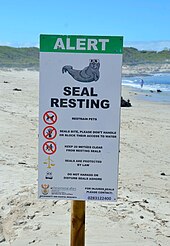
Once a year, elephant seals go through a process called molting where they shed the outer layer of hair and skin.[11] This molting process takes up to a month to complete.[11] When it comes time to molt, they will haul out on land to shed their outer layer, and will not consume any food during this time.[11] The females and juveniles will molt first, followed by the sub adult males, and finally the large mature males.[11]
Predators
The main
Milk stealing
Status
The
Gallery
-
Southern elephant seal
-
Northern elephant seals on Piedras Blancas beach, nearSan Simeon, California
-
Northern elephant seal male, female and pup
-
Northern elephant seals during molting season at Piedras Blancas beach, near San Simeon, California
-
Two northern elephant seal bulls fighting
-
Male northern elephant seal snout
-
Juvenile southern elephant seal
-
Dominant southern elephant seal bulls fighting at Macquarie Island
-
Northern elephant seals at Piedras Blancas, California
See also
- Marine Mammal Center
- Penelope Seal
- Marine Life
- Super weaner
References
- ^ "WCS Chile > Especies > Elefantes marinos". programs.wcs.org. Retrieved 27 May 2016.
- ^ S2CID 133343398.
- hdl:10539/16409.
- .
- PMID 33391813.
- PMID 33171079.
- PMID 19593366.
- ^ Gray, John Edward (1827). "Synopsis of the species of the class Mammalia". In Baron Cuvier (ed.). The Animal Kingdom Arranged in Conformity with its Organization, by the Baron (G) Cuvier, with additional descriptions by Edward Griffith and others. Vol. 5. Printed for G.B. Whittaker. p. 180.
- ^ Threatened Species Scientific Committee (7 December 2016). "Conservation Advice: Mirounga leonina, southern elephant seal" (PDF). Australian Government, Department of Agriculture, Water, and the Environment. Retrieved 16 May 2020.
- ^ a b c d e f g h i j Macdonald, David (2009). Princeton Encyclopedia of Marine Mammals. Princeton University Press.
- ^ )
- ^ a b c d e Thewissen, Würsig, and Perrin, J.M., B.G., and W.F. (2009). Encyclopedia of Marine Mammals. Amsterdam: Academic Press.
{{cite book}}: CS1 maint: multiple names: authors list (link) - ^ Mirounga. "Elephant Seal, Elephant Seal Profile, Facts, Information, Photos, Pictures, Sounds, Habitats, Reports, News – National Geographic". Animals.nationalgeographic.com. Archived from the original on 14 June 2007. Retrieved 8 January 2009.
- PMID 6527090.
- ^ "Elephant Seals". Parks.ca.gov. 23 May 2007. Retrieved 8 January 2009.
- ^ "Elephant Seal – MSN Encarta". Encarta.msn.com. Archived from the original on 28 October 2009. Retrieved 29 December 2009.
- ^ a b Amos, Jonathan (21 February 2006). "Elephant seals dive for science". 2006. BBC News. Retrieved 23 April 2013.
- ^ "Southern Elephant Seals of Sea Lion Island – A Long-term Research Project" (PDF). Eleseal.org. Retrieved 21 May 2010.
- PMID 24670984.
- ^ "Census of Marine Life – From the Edge of Darkness to the Black Abyss" (PDF). Coml.org. Retrieved 15 December 2009.
- PMID 22615801.
- ^ "5.4 Seals". Classroom Antarctica. Archived from the original on 1 June 2011.
- ^ "Northern Elephant Seal Fact Sheet" (PDF). Coastside State Parks Association. Archived from the original (PDF) on 13 May 2013. Retrieved 26 March 2013.
- ^ a b Laws, R (1956). "The Elephant Seal: General, Social, and Reproductive Behavior". Falkland Islands Dependencies Survey. 13.
- ^ "Elephant Seals | National Geographic". National Geographic Society. 10 May 2011. Archived from the original on 23 February 2017.
- ISSN 0008-4301.
- ^ ISSN 0022-2372.
- ISSN 0022-2372.
- S2CID 246018225.
- ^ Sazima. "Cleaner birds: an overview for the Neotropics". Museu de Zoologia, Universidade Estadual de Campinas. 10 (4).
- ^ Chester (1993). Antarctic birds and seals.
- .
- ^ "Antarctica's Milk-Stealing, Grudge-Holding Seabirds". Boston NPR. 2016.
- ^ "NORTHERN ELEPHANT SEAL (Mirounga angustirostris) : California Breeding Stock" (PDF). Media.fisheries.noaa.gov. Retrieved 19 March 2022.
- ^ Krieger, Lisa M. (20 January 2024). "Once nearly extinct, Elephant seals staking claims". The Columbian. Retrieved 1 April 2024.
External links
- Tagging of Pacific Predators, Elephant Seals
- Friends of the Elephant seal
- Elephant Seal Research Group
- Elephant seals -California State Parks
- Dr. Daniel Costa's Research Laboratory Archived 2011-07-16 at the Wayback Machine
- Elephant Seals at Race Rocks, Canada
- Teen Spots Hagfish-Slurping Elephant Seal – YouTube (2:11)
- Elephant Seals - National Geographic









